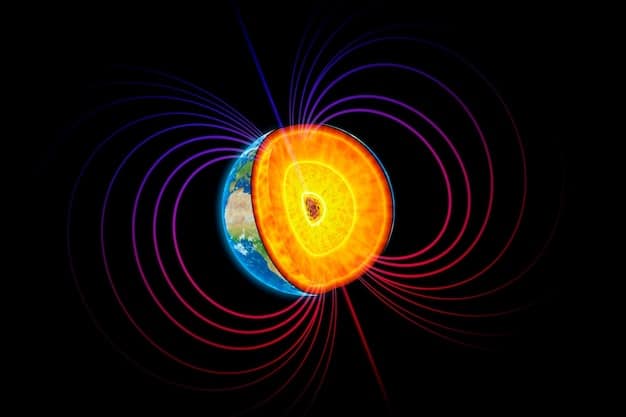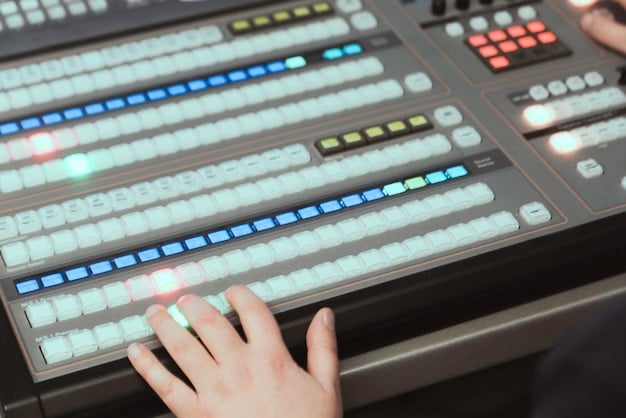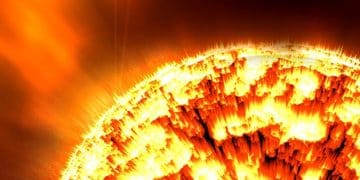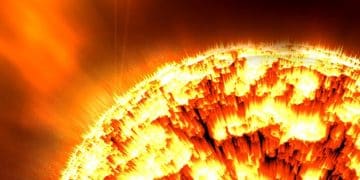Solar Eclipse 2025: How It Will Affect US Radio Communications

The solar eclipse on March 29, 2025, is expected to significantly impact radio communications across the US, potentially causing disruptions and changes in signal propagation due to alterations in the ionosphere.
Get ready for a celestial event with potential terrestrial consequences! The upcoming solar eclipse in 2025 could have a noticeable effect on radio communications across the US. But just how will this happen?
Understanding Solar Eclipses and the Ionosphere
Solar eclipses are stunning astronomical events, but their influence extends beyond visual spectacle. They can significantly impact the ionosphere, the layer of Earth’s atmosphere that plays a critical role in radio wave propagation. Let’s delve into the connection.
What is the Ionosphere?
The ionosphere is a region of the upper atmosphere, ranging from about 60 km to 1,000 km above the Earth’s surface. It’s characterized by the presence of ions and free electrons, created by solar radiation.
How Solar Radiation Affects the Ionosphere
Solar radiation, particularly ultraviolet (UV) and X-ray radiation, ionizes atmospheric gases, leading to the formation of the ionosphere. This ionization varies with solar activity, time of day, and season.
- During the day, solar radiation is strongest, creating a denser ionosphere.
- At night, the recombination of ions and electrons reduces the density of the ionosphere.
- Solar flares and other solar events can cause sudden and significant changes in the ionosphere.
In essence, the ionosphere acts as a reflector for radio waves, enabling long-distance communication beyond the horizon. Changes in its density and structure can therefore impact the quality and reliability of radio signals.

The 2025 Solar Eclipse Path Across the US
The path of totality for the March 29, 2025, solar eclipse will cross a significant portion of the US. Understanding this path is crucial for predicting its impact on radio communications.
Tracing the Eclipse Path
The eclipse will begin in the Pacific Ocean and make landfall on the US West Coast, moving across several states before exiting into the Atlantic Ocean. Key states within the path of totality include California, Nevada, Utah, Colorado, Kansas, Oklahoma, Arkansas, Mississippi, Alabama, and Florida.
Areas of Greatest Impact
The areas experiencing the greatest obscuration of the sun will likely experience the most pronounced effects on radio communications. These are the regions directly within the path of totality.
Timing and Duration
The exact timing and duration of the eclipse will vary depending on the location. The closer a location is to the center of the path of totality, the longer the period of darkness will last.
Knowing the specific path, timing, and duration allows radio operators and communication professionals to prepare for potential disruptions in advance.
Predicted Effects on Different Radio Frequencies
The 2025 solar eclipse is expected to affect various radio frequencies differently. Understanding these potential impacts is vital for maintaining reliable communication during the event.
High Frequency (HF) Radio
HF radio, used for long-distance communication, relies heavily on the ionosphere for signal propagation. During the eclipse, the reduced solar radiation can cause a decrease in the density of the ionosphere, leading to:
- Changes in the skip distance, affecting the range of communication.
- Increased signal attenuation, making it harder to receive signals.
- Potential fading and signal loss, disrupting communication links.
Very High Frequency (VHF) and Ultra High Frequency (UHF) Radio
VHF and UHF radio, commonly used for local communication and broadcasting, are less reliant on the ionosphere. However, they can still be affected by changes in atmospheric conditions caused by the eclipse.
Satellite Communications
Satellite communications might experience minor effects due to changes in the ionosphere, but these are generally less significant compared to HF radio. Signal scintillation, a rapid fluctuation in signal amplitude and phase, could occur but is unlikely to cause major disruptions.
Different frequencies react in distinct ways to the eclipse-induced changes in the ionosphere. Therefore, careful planning is essential for uninterrupted communication.
Preparing for Communication Disruptions
Given the potential disruptions, it’s crucial for radio operators, emergency services, and businesses to prepare for the 2025 solar eclipse. Proactive measures can mitigate the impact on communication systems.
Backup Communication Systems
Having backup communication systems in place is essential. This could include:
- Using alternative frequencies that are less susceptible to ionospheric changes.
- Implementing satellite-based communication systems.
- Establishing redundant communication paths.
Monitoring and Testing
Regular monitoring of radio signals and communication systems before, during, and after the eclipse is crucial. This helps identify any anomalies and allows for quick adjustments.
Adjusting Communication Strategies
Adjusting communication strategies based on real-time conditions can help maintain reliable communication. This could include:
By taking these proactive steps, organizations can minimize the impact of the solar eclipse on their communication systems and ensure continued operation.

Long-Term Effects and Research Opportunities
Besides the immediate disruptions, the 2025 solar eclipse provides valuable research opportunities to study the ionosphere and improve our understanding of radio wave propagation.
Studying Ionospheric Changes
Solar eclipses offer a unique opportunity to study the ionosphere under controlled conditions. By observing the changes in ionospheric parameters during the eclipse, scientists can gain insights into:
- The dynamics of ionospheric plasma.
- The impact of solar radiation on the upper atmosphere.
- The behavior of radio waves in a changing environment.
Improving Prediction Models
The data collected during the eclipse can be used to refine existing models of ionospheric behavior and radio wave propagation. This, in turn, can improve the accuracy of predictions for future solar events.
The 2025 solar eclipse is not just a temporary event but also a chance to advance scientific knowledge and refine our communication strategies.
Mitigation Strategies for Radio Operators
For individual radio operators and enthusiasts, understanding mitigation steps is important to ensure reliable communication despite the eclipse’s impact. Consider these actions:
Optimizing Antenna Systems
Ensure your antenna system is performing optimally before the eclipse. This includes:
A well-maintained antenna system can improve signal strength and coverage, helping to overcome potential signal attenuation during the eclipse.
Utilizing Digital Communication Modes
Digital communication modes, such as FT8 and other weak signal modes, are more robust and can often maintain communication even under degraded conditions. Experiment with these modes to see if they provide better performance during the eclipse.
Community Collaboration
Connect with other radio operators and share real-time observations during the eclipse. Sharing information about signal conditions and effective frequencies can help everyone adapt and maintain communication.
With careful planning, optimized equipment, and community support, radio operators can mitigate the effects of the solar eclipse on their communication activities.
Radio Frequency Impact
Disruptions in long-distance communication.
Signal degradation possible but typically minimal.
Studying eclipse aftermath.
Proactive steps mitigate signal decline.
FAQ: Solar Eclipse and Radio Communications
During a solar eclipse, the moon blocks sunlight leading to localized cooling & reduced ionization in the ionosphere. This alters how radio waves are refracted and reflected.
Areas directly under the path of totality will experience the most pronounced effects, due to higher darkness and resultant reduction in the ionization levels during the eclipse.
Mobile phones primarily rely on satellite and terrestrial signals with minimal impact on communication. Potential overload of cell towers is possible due to spectators however.
Amateur radio operators can optimize their antenna systems, test backup strategies, and monitor frequencies for signal degradation for radio disruptions. Coordinate observations with other operators.
Predicting complete signal loss is challenging as it depends on weather conditions and equipment. Continuous monitoring using the strategies previously suggested give the best predictive capabilities.
Conclusion
The solar eclipse of March 29, 2025, presents both challenges and opportunities for radio communication across the US. While disruptions are possible, preparation, monitoring, and a spirit of community collaboration can mitigate the impact and deepen our understanding of the complex relationship between celestial events and terrestrial technology.
Cosmic Events” style=”background-color: #000000; color: white; border: 1px solid #000000; cursor: pointer; padding: 8px 16px; border-radius: 8px; display: inline-block; margin: 0 auto; text-align: center; white-space: nowrap; transition: background-color 0.3s ease; text-decoration: none;”>Read more content





